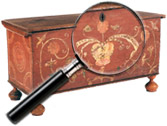|
|
James Reid Lambdin (1807-1889)
James Lambdin was born in Pittsburgh and at age 13, he was studying with John Stein in Steubenville, Ohio. He then went to Philadelphia where he studied with Edward Miles and Thomas Sully. In 1826, he returned to Pittsburgh and opened up the Museum of Natural History and Gallery of Painting. In 1832, he moved to Louisville, Kentucky, and spent several years as an itinerant painter traveling between Pittsburgh and [...] Click here to continue reading.
Gerald Laing (British, born 1936)
Gerald Laing began his career as a British Pop artist in the 1960s and has worked in many media, including paint and sculpture, in both abstract and figural styles. During the 1960′s, Laing was mainly producing shaped abstract paintings which relied on techniques used in car manufacture, including lacquering and electroplating. Three of his works from this period were included in the Jewish Museum of Art’s exhibition entitled “Primary [...] Click here to continue reading.
L.A. Huffman (1854 to 1931)
Laton Alton Huffman opened his first photographic studio in December 1878 at the military post of Fort Keogh, Montana Territory where he made portraits of the soldiers, Indians and cowboys near the fort, and buffaloes. Venturing beyond, he photographed the Custer battlefield site. He moved his studio to Miles City but the economic depression of 1890 destroyed business and he closed shop traveling to California, Chicago. In 1896 he [...] Click here to continue reading.
Kunisada (or Toyokuni III) (1786-1864)
Born in 1786 in the Honjo district of Edo Kunisada’s father died the same year and little is known about family as it traveled from one province to another.
Kunisada grew to young adulthood during the Kansei era, 1789 to 1801, which produced some of the best Ukiyo-e artists, like Utamaro or Toyokuni I, founder of the Utagawa School Toyoku. By the age of nineteen, Kunisada was under the [...] Click here to continue reading.
Max Kuehne (1880-1968)
Max Kuehne was born in Halle, Germany in 1880. He later came to New York and studied with Kenneth Hayes and William Merritt Chase at the Chase School. He traveled extensively throughout his life, but it was Cape Ann that became artist Max Kuehne’s favorite destination. An athlete as well as an artist, he eventually set up a studio in Rockport in 1920 in order to spend every summer painting, sailing, [...] Click here to continue reading.
Leon Kroll (1884-1974)
Leon Kroll first established his reputation between 1911 and 1915 as a painter of powerful views of the bridges, wharves and riverfronts of New York City. Although Kroll loved to tell of his inadvertent discovery of Cezanne’s and Van Gogh’s paintings when he was an art student in Paris, Kroll’s early New York scenes are in fact a great deal closer in their painterly style and progressive spirit to the [...] Click here to continue reading.
Sam Kramer (1913-1964)
Now considered the most important post-war Modernist jeweler, Kramer was a Surrealist artist who worked in the biomorphic style. Among the first of the Greenwich Village studio jewelers (est. 1940), Kramer advertised his work as “Fantastic Jewelry for People Who are Slightly Mad”. A self-described rockhound, Kramer studied gemology and developed a fondness for precious stones as well as exotic materials, from Burmese rubies to glass eyes. Kramer’s work emphasizes the [...] Click here to continue reading.
Aleksander Koshkin
Aleksander Koshkin is renowned for his illustrations throughout Russia and Europe. He has illustrated a two-volume set of Grimm’s fairy tales, published in Italy and Kipling’s The Jungle Book, published in Spain. He also illustrated a Russian version of the Pinocchio story, The Adventures of Buratino, which won the bronze medal at the International Children’s Book Contest in Leipzig in 1981.
A Kirkus pointer review called his work “outstanding, full of [...] Click here to continue reading.
Sharon Kopriva (American, born 1948)
Houston artist Sharon Kopriva has gained accolades and provoked strong reactions throughout the world for her paintings and sculptures, which exhibit the influences of her Catholic background and a trip to Peru in 1981. These experiences, cultural, political, and religious, have contributed much to the development of her iconic and often humorous images of expressionistic mummy-like figures. Studying with New York painter John Alexander, as well as Texas sculptor [...] Click here to continue reading.
Adolf Ferdinand Konrad (1915-2003)
Adolf Konrad’s perceptions and observations are multifaceted and his pictorial images reflect a wide range of feelings and ideas,” said Harry Naar, professor of fine arts and director of Rider University’s Art Gallery. “Within Konrad’s work, the ordinary becomes the extraordinary.” His traditional works include cityscapes, Victorian period images or landscapes – images most known to the public – but range to widely appreciated still-life compositions.
Hailed by Gov. Thomas [...] Click here to continue reading.
|
Recent Articles
- Charles Alfred Meurer – American Artist & Tromp L’Oeil Artist
- Sendak, Maurice – American Artist & Writer
- Godie, Lee – American Artist
- Davis, Vestie – American Artist
- Bartlett, Morton – American Artist
- Mackintosh, Dwight – American Artist
- Evans, Minnie Jones – African-American Artist
- Mumma, Ed (Mr. Eddy) – American Artist
- Nice, Don – American Artist
- Savitsky, John (Jack) – American Artist
- Gordon, Harold Theodore (Ted) – American Artist
- Dial, Thornton – African-American Artist
- Doyle Sam – American Artist
- Johnson, Lester Frederick – American Artist
- Finster, Howard – American Artist
|
|
